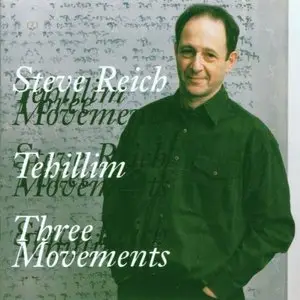Steve Reich: Tehillim/Three Movements for Orchestra (1994)
Classical | EAC (APE & CUE) | 214 MB
Classical | EAC (APE & CUE) | 214 MB
Tehillim begins with a joyful noise that just about bypasses the brain altogether and heads directly for the feet. If you can keep your feet from tapping or your fingers from snapping, you probably can also eat just one potato chip. The basic idea is essentially a complex one, more than enough to belie the label "minimalist." However, Reich unfolds his ideas slowly and carefully - he prefers to call what he writes "process music" - and instead of listening for dramatic contrasts of themes or a narrative structure underlying the music, you find yourself listening to a process working itself out. It has the fascination of watching intricate clockwork. However, like Schoenberg and Webern before him, Reich forces you to listen to music in a new way.
The first of the Three Movements for Orchestra takes the idea of phase and gives it a spatial component. This is true stereophonic - as opposed to merely antiphonal - music. Violins divide left and right, Reich exploits instrumental ambiguities, especially between flutes and strings. The piece presents a rapid, even pulse of, according to the liner commentary, eighth notes. However, as in Balinese music, no one part plays all of these eighths. One part "inserts" its notes in between the notes of another part - the Balinese solution to playing rapidly. The pulse "moves" from left to right and back throughout the movement as various instruments take it up, and there's a kind of overlap of instrumental colors as well. I've not seen the score, but I'd be willing to bet that Reich specifies the placement of all players. In this movement, you hear with two sets of ears - one set catches the constant pulse as it shifts position; the other catches, through the different instrumental colors, the individual rhythms that make up the pulse. The second movement strikes me as Middle Eastern or Islamic North African in its inspiration, with European canon thrown in - in a kind of languorous, sensuous dance. Reich says the third movement comes from West African music. It plays with shifting accents on the same note values, as if different players were to start their measures at different places in the constant pulse. To me, it sounds like a combination of Brazilian samba and hard bop.
―Steve Schwartz
Tracklist
1. Tehillim For Voices And Ensemble: Part I: Fast
2. Tehillim For Voices And Ensemble: Part II: Fast
3. Tehillim For Voices And Ensemble: Part III: Slow
4. Tehillim For Voices And Ensemble: Part IV: Fast
5. Three Movements For Orchestra: Movement I: =176
6. Three Movements For Orchestra: Movement II: =88
7. Three Movements For Orchestra: Movement III: =176
Nonesuch 79295-2
♪♫♪♫ The orchestral version of Tehillim in this Nonesuch release is in every respect a better interpretation of Reich's music than the ECM disc (which you can find here). The ECM version, which is ironically led by the composer himself, sucks in comparison to the Nonesuch disc, which features de Leeuw's Schönberg Ensemble who tends to bring more color to Tehillim than the former. Plus, the bonus of the Three Movements pretty much knocks the ECM out hands down. Don't worry, you're not exactly stealing crumbs from Reich's lips.





